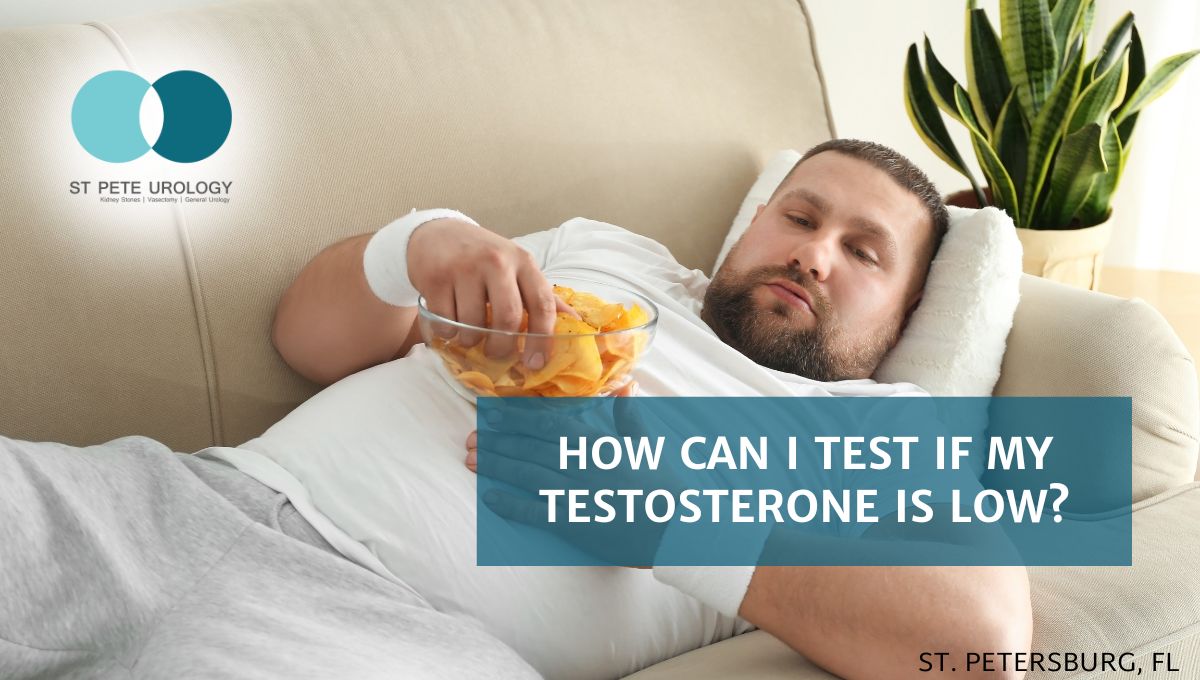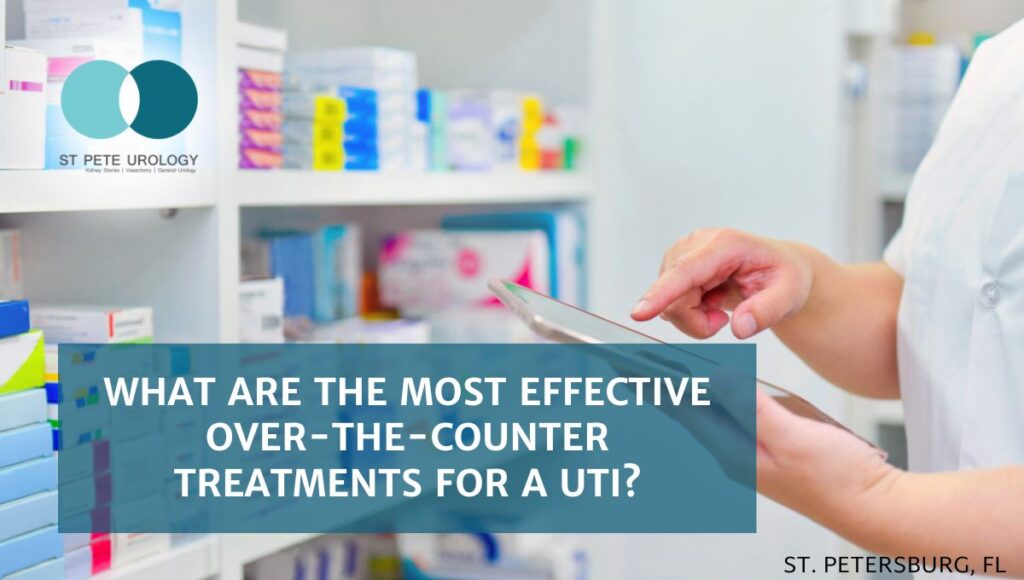3 Key Takeaways:
- Morning testing between 7-10 AM is critical because testosterone levels peak early and decline 20-30% by evening, making accurate diagnosis dependent on proper timing.
- Confirmed diagnosis requires two separate blood tests showing total testosterone below 300 ng/dL, paired with three or more persistent symptoms lasting at least three months.
- Treatment raises testosterone to 400-700 ng/dL within 4-6 weeks, with energy and mood improvements appearing first, followed by restored sexual function over 4-12 months.
 How to test testosterone levels starts with recognizing symptoms and scheduling a simple blood test with a qualified urologist. At St Pete Urology, we diagnose approximately 150 men with low testosterone annually through comprehensive testing that measures total and free testosterone levels, typically performed between 7-10 AM when levels peak naturally.
How to test testosterone levels starts with recognizing symptoms and scheduling a simple blood test with a qualified urologist. At St Pete Urology, we diagnose approximately 150 men with low testosterone annually through comprehensive testing that measures total and free testosterone levels, typically performed between 7-10 AM when levels peak naturally.
Low testosterone affects 20-40% of men over age 45, yet many delay testing for years after symptoms begin. This delay creates unnecessary complications—from reduced bone density to increased cardiovascular risk—when early detection through proper testing could prevent these outcomes. Understanding when and how to test your testosterone empowers you to address this treatable condition before it significantly impacts your health and quality of life.
Why Testosterone Testing Matters
Testosterone production naturally declines at 1-2% per year after age 30, but pathological low testosterone—medically termed hypogonadism—requires intervention. The condition affects 4-5 million American men, according to the American Urological Association, yet fewer than 10% receive diagnosis and treatment.
Untreated low testosterone increases your risk of osteoporosis by 40% within five years, based on data from the National Institutes of Health. Men with testosterone levels below 300 ng/dL face twice the risk of developing metabolic syndrome compared to those with normal levels. At St Pete Urology, our board-certified urologists see these complications daily in patients who waited too long to get tested.
Testing matters because symptoms of low testosterone overlap with other medical conditions. Without a blood test, you can’t distinguish between normal aging, depression, thyroid problems, or genuine testosterone deficiency. A 52-year-old patient recently came to our St. Petersburg clinic assuming his fatigue stemmed from work stress—his testosterone measured 180 ng/dL, well below the 300-900 ng/dL normal range.
The role of hormones extends beyond sexual function. Testosterone regulates bone density, muscle mass, red blood cell production, and fat distribution. Early testing catches deficiencies before they cascade into multiple health problems.
Common Symptoms That Indicate Low Testosterone
Men typically notice erectile dysfunction first—this symptom drives 60% of initial consultations at our practice. But sexual problems represent just one category of symptoms. Physical symptoms include persistent fatigue despite adequate sleep, decreased muscle mass with increased body fat (especially around the abdomen), and reduced bone density leading to fractures from minor injuries.
Cognitive and emotional symptoms matter equally. Men report difficulty concentrating, memory problems, mood swings, and depression that doesn’t respond to standard antidepressants. One patient described it as “mental fog that wouldn’t lift.” His total testosterone measured 220 ng/dL—treatment restored both his mental clarity and energy within 12 weeks.
Sleep disturbances appear in 45% of low testosterone cases, according to research published in the Journal of Clinical Endocrinology & Metabolism. Hot flashes affect 20-30% of men with severe deficiency. These symptoms typically worsen gradually over 2-3 years, making them easy to dismiss as “just getting older.”
The key distinction: symptoms that interfere with daily activities warrant testing. If you’re canceling social plans due to fatigue, avoiding intimacy due to erectile dysfunction concerns, or struggling at work due to concentration problems, schedule a testosterone test.
How Doctors Test Testosterone Levels
Testing testosterone levels requires blood work, specifically a serum total testosterone test performed between 7-10 AM. Morning testing is critical—testosterone levels follow a circadian rhythm, peaking in early morning and declining 20-30% by evening. A 9 AM sample reading 350 ng/dL might drop to 245 ng/dL by 5 PM, potentially leading to misdiagnosis if tested later.
What is testosterone testing? The standard diagnostic process includes:
Total Testosterone Test: Measures both bound and free testosterone in your bloodstream. Normal ranges vary by lab but typically span 300-900 ng/dL for adult men. This test costs $40-80 without insurance.
Free Testosterone Test: Measures the 2-3% of testosterone not bound to proteins, representing the biologically active portion. Free testosterone below 50 pg/mL indicates deficiency even when total testosterone appears borderline normal.
Luteinizing Hormone (LH) and Follicle-Stimulating Hormone (FSH): These pituitary hormones signal the testes to produce testosterone. Abnormal LH/FSH ratios help identify whether low testosterone originates from testicular failure (primary hypogonadism) or pituitary/hypothalamic problems (secondary hypogonadism).
Sex Hormone-Binding Globulin (SHBG): This protein binds testosterone, reducing the free active hormone. High SHBG can cause symptoms even when total testosterone appears normal.
The Endocrine Society recommends confirming low results with a second test before diagnosis. At St Pete Urology, Dr. Reid Graves typically orders both morning tests 2-4 weeks apart, then adds comprehensive panels if initial results show deficiency.
At-home testosterone test kits, available for $50-150, measure testosterone through saliva or finger-prick blood samples. While convenient, these tests lack the accuracy of laboratory serum tests. The FDA hasn’t approved most at-home tests for diagnostic purposes—they’re screening tools, not diagnostic tests. A low at-home result should prompt proper testing at a urology clinic.
When to Get Tested
Men should consider testosterone testing if they experience three or more symptoms for at least three months. Age 35+ with any sexual dysfunction symptoms warrants immediate testing. The Mayo Clinic recommends baseline testing for all men at age 40, especially those with risk factors.
Specific situations requiring immediate testing include:
- Type 2 diabetes diagnosis (40% of diabetic men have low testosterone)
- Obesity with BMI over 30 (adipose tissue converts testosterone to estrogen)
- Chronic opioid use (opioids suppress testosterone production by 50-80%)
- History of testicular injury or cancer treatment
- Pituitary tumor diagnosis
- Chronic illness affecting the liver or kidneys
- HIV/AIDS diagnosis
Athletes and bodybuilders who’ve used anabolic steroids need testing—even years after discontinuation, natural testosterone production may not fully recover. We test these patients annually for 5 years post-steroid use.
Men’s sexual health concerns often mask underlying hormone imbalances. A patient came to our St. Petersburg office seeking erectile dysfunction treatment, assuming he needed medication. Testing revealed testosterone at 195 ng/dL—hormone replacement therapy resolved his ED without additional medications.
Timing matters for accurate results. Avoid testing during acute illness, which temporarily suppresses testosterone production. Wait 6-8 weeks after recovering from significant infections. Don’t test if you’ve been awake all night—sleep deprivation reduces testosterone by 10-15%.
What to Expect During Testing
The testing process at St Pete Urology begins with a comprehensive consultation. Our urologists review your medical history, current medications, and symptoms using standardized questionnaires like the Androgen Deficiency in the Aging Male (ADAM) questionnaire. This 10-question assessment identifies patients who need laboratory testing.
Blood draw takes 5 minutes. You’ll need to fast for 8-10 hours before morning testing—water is permitted, but skip breakfast and coffee until after the draw. Certain medications affect results: corticosteroids, ketoconazole, and spironolactone all reduce testosterone levels. Discuss all medications and supplements with your urologist before testing.
Results typically return within 24-48 hours. Normal results don’t require follow-up unless symptoms persist. Borderline results (250-350 ng/dL) warrant repeat testing in 2-4 weeks. Confirmed low testosterone (<300 ng/dL) leads to expanded testing: complete blood count, comprehensive metabolic panel, lipid panel, and prostate-specific antigen (PSA) test before starting treatment.
The National Institutes of Health notes that testosterone testing has increased 300% over the past decade. This surge reflects both greater awareness and aging demographics—baby boomers now comprise the age group most affected by testosterone decline.
Treatment Options After Diagnosis
Confirmed low testosterone opens several treatment pathways. Testosterone replacement therapy (TRT) comes in multiple forms:
Injections: Testosterone cypionate or enanthate injected every 1-2 weeks provides stable levels but requires office visits or self-administration skill. Cost: $30-100 monthly.
Topical Gels: Daily application to shoulders or abdomen offers consistent absorption but risks transfer to partners and children through skin contact. Cost: $200-500 monthly without insurance.
Patches: Applied nightly to back, abdomen, arms, or thighs. Skin irritation affects 30% of users. Cost: $150-300 monthly.
Pellets: Implanted under skin every 3-4 months, releasing steady testosterone. Requires minor surgical procedure. Cost: $400-700 per insertion.
Treatment typically raises testosterone to 400-700 ng/dL within 4-6 weeks. Energy and mood improve first, followed by increased muscle mass and bone density over 3-6 months. Sexual function improvements appear within 4-8 weeks but may take up to 12 months for full restoration.
Dr. Adam Oppenheim monitors patients every 3-6 months during the first year of treatment, checking testosterone levels, blood counts, and PSA. Some patients need dosage adjustments to maintain optimal levels while minimizing side effects.
Not every man with low testosterone needs medication. Weight loss of 10-15% can raise testosterone by 50-100 ng/dL. Regular strength training increases production by 20-30%. Adequate sleep—7-9 hours nightly—supports healthy testosterone levels. Stress reduction through meditation or counseling helps patients with mild deficiency avoid medication.
Conclusion
Testing your testosterone levels requires a simple morning blood test that takes less than 10 minutes. The process starts with recognizing symptoms—persistent fatigue, reduced libido, difficulty concentrating, or decreased muscle mass. Schedule testing with a board-certified urologist if these symptoms last three months or longer, especially if you’re over 35.
Early detection prevents the cascade of health problems associated with untreated testosterone deficiency, from osteoporosis to cardiovascular disease. The test itself costs $40-80 without insurance, a small investment compared to the long-term health costs of ignoring symptoms.
Take action today: Contact St Pete Urology at (727) 478-1172 to schedule your testosterone testing consultation. Our St. Petersburg clinic offers same-week appointments with experienced urologists who specialize in men’s hormonal health. Don’t wait until symptoms worsen—early testing and treatment restore your energy, strength, and quality of life.
References:
- American Urological Association. (2018). Evaluation and Management of Testosterone Deficiency: AUA Guideline. Journal of Urology, 200(2), 423-432. https://www.auanet.org/guidelines-and-quality/guidelines/testosterone-deficiency-guideline
- Endocrine Society. (2018). Testosterone Therapy in Men with Hypogonadism: An Endocrine Society Clinical Practice Guideline. Journal of Clinical Endocrinology & Metabolism, 103(5), 1715-1744. https://www.endocrine.org/clinical-practice-guidelines/testosterone-therapy-in-men-with-hypogonadism
- National Institutes of Health. (2020). Understanding How Testosterone Affects Men. NIH Research Matters. https://www.nih.gov/news-events/nih-research-matters/understanding-how-testosterone-affects-men
- Mayo Clinic. (2023). Testosterone Therapy: Potential Benefits and Risks as You Age. Mayo Clinic Health System. https://www.mayoclinic.org/healthy-lifestyle/sexual-health/in-depth/testosterone-therapy/art-20045728





